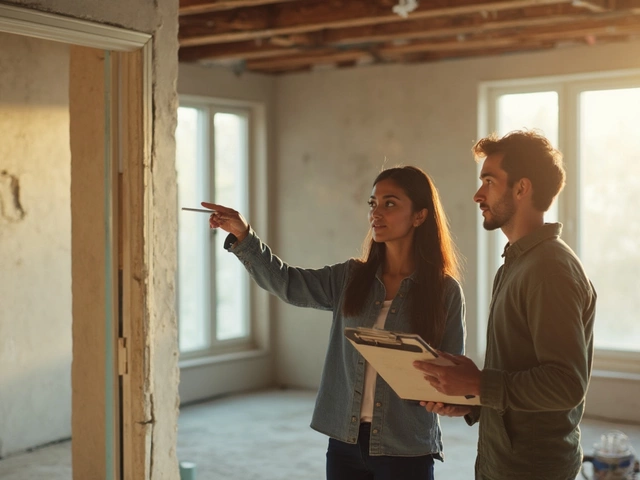If you're dreaming about building your own home, money is probably right at the top of your worry list. Prices for new builds in 2025 haven’t exactly gone down—materials are still expensive, labor costs keep climbing, and land doesn’t come cheap anywhere worth living. People love the idea of picking every detail of their house, but the cold truth is, those custom touches can push your final bill way past your starting budget.
So is building actually smart with your money right now? To answer that, you need to get real about the numbers: what you pay for land, permits, lumber, concrete, labor—the list adds up fast. New home builders in the US say that the average cost is edging over $450,000 in most decent areas, and that’s not even counting landscaping or all the little add-ons.
But here’s something a lot of folks miss: sometimes, building lets you skip the old problems that come with fixer-uppers, like leaky roofs or scary wiring. That means fewer surprise repairs later, which saves cash in the long run—and if you plan it right, things like solar panels and good insulation can actually bring your monthly bills way down. It’s not just about the upfront cost; you have to look at the bigger picture to see if building a house really works for your wallet.
- Sticker Shock: The Real Cost of Building
- Building vs. Buying: Who Wins in 2025?
- Surprise Expenses Nobody Warns You About
- Saving Money Without Cutting Corners
- Payoffs: Customization, Energy Bills, and Future Value
- Is Building Your Smartest Move?
Sticker Shock: The Real Cost of Building
Let’s cut to the chase: building a house never comes cheap, and build a house costs have only gone up lately. The National Association of Home Builders put the average new single-family home price over $485,000 in early 2025. That doesn’t include land, which can be anywhere from $50,000 for a quarter-acre in smaller towns to $300,000 or more near major cities.
Most people expect to line up costs by room or square footage, but it’s easy to miss how fast things snowball. Here’s what typically adds up:
- Permits and fees: Zoning, builders’ permits, and utilities can hit $15,000-$40,000 depending on where you live.
- Materials: Lumber alone has swung 25% in price over the last 18 months. Concrete, steel, drywall—every bit adds hundreds or thousands as supply chains shift.
- Labor: Skilled trades like framing, electrical, and plumbing are in short supply. Labor can take up 30–50% of your whole budget.
- Professional fees: Don’t forget architects, engineers, and surveyors. Even on a basic build, these can set you back $10,000 to $30,000.
- Unexpected costs: Rock you need to blast? Hidden drainage problems? Figure on at least a 10% wiggle room for surprises.
There’s also lender interest, insurance, landscaping, the price of driveways, and yes, those must-have appliances. If you want major upgrades—like granite everywhere, smart home gear, or a finished basement—tack on another 10–20% easily. By the time you turn the key, it’s common for buyers to spend 15% more than their original budget.
The best way to avoid big shocks is to ask for itemized quotes from builders and get a walkthrough of every step. Never sign anything unless you see clear estimates for each part of the process, and don’t be shy about questioning weirdly high numbers. Small details make a big difference to your bottom line, and being hands-on and realistic early will save you a ton of stress and even more money when the bills start rolling in.
Building vs. Buying: Who Wins in 2025?
The big debate in 2025: is it smarter to buy a ready-made house or go all-in on a new build? Each path has its own price tags, headaches, and perks. According to Redfin and NAHB data, the median price for a new single-family house in the U.S. this year is around $443,000, while the median for an existing home sits closer to $393,000. But don’t stop at sticker price—there’s way more under the hood.
| Build New | Buy Existing | |
|---|---|---|
| Median Total Cost | $443,000 | $393,000 |
| Avg. Time to Move In | 9-16 months | 30-60 days |
| Custom Features | Yes | Limited |
| Major Repairs in First 10 Years | Unlikely | Likely |
When you build a house, you pay more up front—almost always. That’s because you control everything, from floor plans to fixtures, and those choices add up. But modern builds mean better insulation, new appliances, and fresh wiring, which can save a bunch on utility bills and repairs for years. Plus, if you want an open kitchen or a specific layout, you can make it happen—no compromises.
Buying, on the other hand, usually gets you the keys way faster. It’s often more affordable at the start, and the neighborhood is already established. But you might settle for things you don’t like: weird layouts, tiny closets, or old plumbing that’s ready to give up. Factor in the cost of fixing problems or updating the look, and sometimes that lower price starts creeping upward.
There’s also resale value. New builds with popular layouts and solid upgrades tend to snag higher prices when it’s time to sell. But if you’re in a hot market (like Austin or Denver), even older homes are rising in value—so location is just as important as the house itself.
Here’s what you should compare if you’re torn:
- All-in price you’ll pay in the next 5-10 years (immediate and future repairs, updates, and upgrades)
- How fast you need to move—can you wait a year for a new house?
- Your appetite for stress: do you want to manage builders, or would you rather just sign and move in?
- How much does customizing matter to you? Is picking everything worth the extra cash?
Bottom line: building is usually the premium route—higher up-front cost, lower surprises later. Buying is faster and simpler but watch out for hidden repairs. Crunch your own numbers, because everyone’s budget and patience look a little different.
Surprise Expenses Nobody Warns You About
There's a bunch of costs that catch even the most prepared people off guard when they start building a house. Sure, you expect to budget for things like concrete and windows. But what about fees to connect your sewer line? Or those sudden price hikes in lumber because a storm just wiped out half the supply on the East Coast?
Here’s a look at some of the most common wallet-drainers that sneak up on new home builders:
- Permits and Inspection Fees: Every city and county has their own set of permit fees—and they almost always cost more than you think. In some areas, permits alone can hit $10,000, especially if you need things like environmental or driveway permits. Plus, you pay inspection fees every step of the way.
- Utility Hookups: You’ll need to get electricity, water, and sewer lines set up. If your land is far from the main road or existing utility lines, the price can jump fast—sometimes $15,000 or more just to get hooked up.
- Site Prep Surprises: Clearing trees, leveling ground, and hauling away rocks isn’t cheap. If they find bad soil or an old septic tank, you can expect an extra $5,000 to $20,000 tacked onto your bill.
- Change Order Charges: Most people don’t realize this, but changing your mind once the build starts can cost a ton. Swapping out flooring or switching up the kitchen layout will cost more than if you’d decided earlier.
- Landscaping and Driveways: Builders usually cover only basic grading. Sod, trees, fencing, or a quality driveway? That comes out of your pocket, and the average homeowner spends around $12,000 finishing it off.
- Loan Interest During Construction: Since you’re not just getting a regular mortgage, you’ll end up paying interest as the house gets built. This adds up over months of paying rent and your construction loan at the same time.
It’s easy to focus on the headline price for the build and miss all the extras that creep in. People who plan for surprise expenses protect themselves from budget meltdowns—and honestly, that’s what makes building a new house less stressful in the end.

Saving Money Without Cutting Corners
Cutting costs doesn’t have to mean sacrificing quality or living with stuff you hate. The trick is knowing where you can trim the fat and where it actually pays off to spend a little more. Getting the basics right will make your build a house project way less stressful and more affordable in the long run.
One way to save? Skip the crazy custom features that drive up labor and materials—think fancy shaped windows or wild rooflines. According to the National Association of Home Builders, keeping your design simple and compact can knock anywhere from 10% to 15% off total costs. Also, using ready-made plans (sometimes called stock plans) instead of hiring an architect to draw up something brand new can save you several thousand bucks right out of the gate.
Here’s where homeowners waste the most cash, according to real builders: upgrade kitchens, luxury bathrooms, and finishing basements before you even move in. Sure, they look great, but adding them later when you can actually afford them is usually smarter. Focus on strong basics—good HVAC, proper insulation, and solid windows—so your home is efficient and comfortable from day one.
"If you put your money into a good roof and efficient heating, you’ll save more over ten years than you could ever make back by picking granite over laminate," says Kevin O’Connor, host of This Old House.
Getting multiple quotes from different contractors (minimum three) is non-negotiable. Prices for the exact same work can vary by 20% or more. Also, don’t overlook local suppliers; national chains sometimes charge more, and smaller shops can often source last-minute materials without crazy markups.
Even little changes add up. Go for standard door sizes, avoid moving plumbing between floors, and skip trends that bump up labor (like open riser staircases). Every project has some flex. If you need a nudge, check out this quick breakdown of where folks usually overspend versus where they save big:
| Area | Average Overspend | Money-Saving Tip |
|---|---|---|
| Kitchen Upgrades | $20,000+ | Leave space for upgrades later |
| Custom Windows | $5,000-$10,000 | Use standard shapes/sizes |
| Labor Costs | Varies ~20% | Get at least 3 bids |
| Plumbing Relocation | $2,000-$6,000 | Keep plumbing minimal and grouped |
Bottom line: Treat your first budget like a rough guess and expect it to change. Put your cash into stuff that lasts (structure, roof, insulation), and keep things flexible so it’s easier on your wallet if prices go up. Building smart beats building flashy every single time.
Payoffs: Customization, Energy Bills, and Future Value
Building your own place isn’t just about bragging rights. When you go the new construction route, you call the shots with customization. Want a massive pantry, heated bathroom floors, or a clever dog wash station? No problem. It’s way cheaper and easier to add this stuff from the start, instead of ripping up an old house later.
Let’s talk about energy bills. New homes in 2025 can easily beat older homes on long-term costs because of tighter building codes, better insulation, and smarter tech. Stuff like high-efficiency HVAC systems, double-pane windows, or solar panels can chop your energy bill by 30% or more right out of the gate. One report from the National Association of Home Builders claims folks save close to $1,200 a year on energy alone when moving from a 20-year-old house to a new build.
Future value also deserves a hard look. A brand new house won’t need big repairs for years, so you avoid surprise costs that kill your savings. Buyers love move-in-ready homes, and newer places usually sell faster and for more cash per square foot. In markets where energy efficiency and customization are hot (think Austin or Denver), resale value stays higher for longer because newer houses age better and feel fresher than the 1970s specials down the street.
- Plan ahead for projects like smart wiring—much cheaper and easier before the walls go up.
- Prioritize upgrades that lower monthly bills, like tankless water heaters or LED lighting.
- Research local trends: In eco-focused areas, solar panels can bump resale price way up.
Customization, savings on bills, and selling for more down the line—those are the big wins you get when you build a house from scratch rather than just buy one off the rack.
Is Building Your Smartest Move?
This is where the rubber meets the road. You’ve seen the costs, the surprises, and the perks. But when does building a house actually make sense—financially and with your lifestyle?
Let’s get one thing straight: building only pays off for certain folks. If you’re after your dream setup in a hot neighborhood and decent homes are selling for sky-high prices, building can actually save you a few bucks long-term. Custom builds give you way more control over quality, layout, and energy use, which can mean fewer fixes and smaller bills for years.
Here’s a quick look at how the numbers stack up, based on recent 2024-2025 data:
| Build New | Buy Existing | |
|---|---|---|
| Average Price (mid-tier city) | $465,000 | $430,000 |
| Customization | High | Low |
| Major Repairs (first 10 years) | Rare | Likely |
| Energy Bills (monthly) | $170 | $250 |
Notice how the upfront build a house cost is a bit higher, but you make up ground later with lower utility bills, almost no big repairs, and layouts that actually work for how you live.
Here are a few situations where building makes the most financial sense:
- You can snag affordable land, maybe through family or at a tax auction.
- Local existing home prices are inflated, and even fixer-uppers look rough.
- You want smart systems (like solar and EV charging) that are expensive to add to old homes.
- You plan to live in the home for at least 7-10 years, letting you recoup the extra upfront cost.
But building isn’t for everyone. Folks who want to move in fast, hate paperwork, panic over deadlines, or don’t have much in the way of emergency funds might be happier (and safer) picking from existing homes. Building is a marathon, not a sprint, and the finish line isn’t always where you expect it.
The smartest move is running the full numbers—no wishful thinking. Grab firm bids from builders, add at least 10% on top for surprise expenses, and compare that to similar homes in your area. Ask yourself: what’s your budget really like, and are you ready to handle months of decisions and delays?




Write a comment